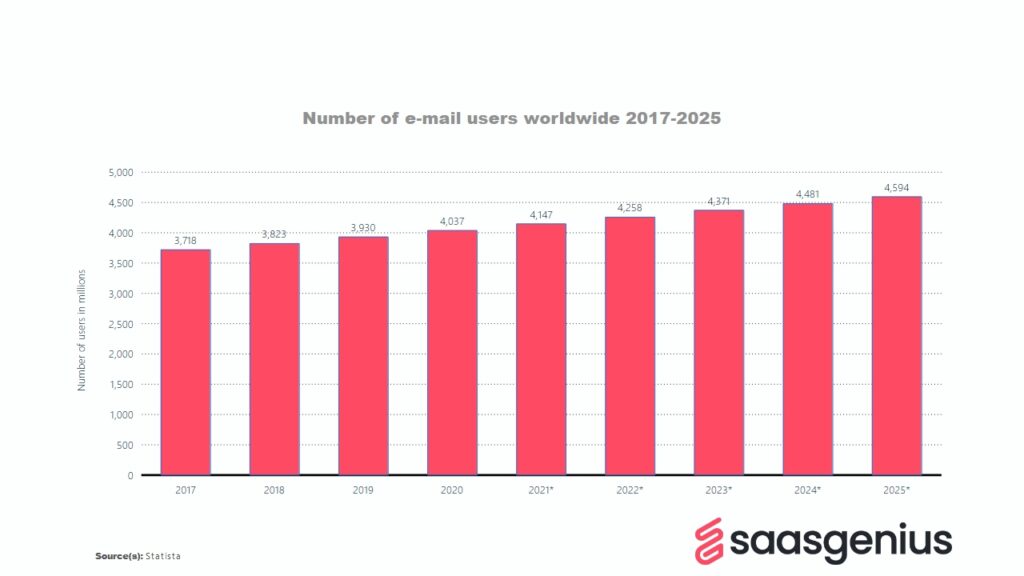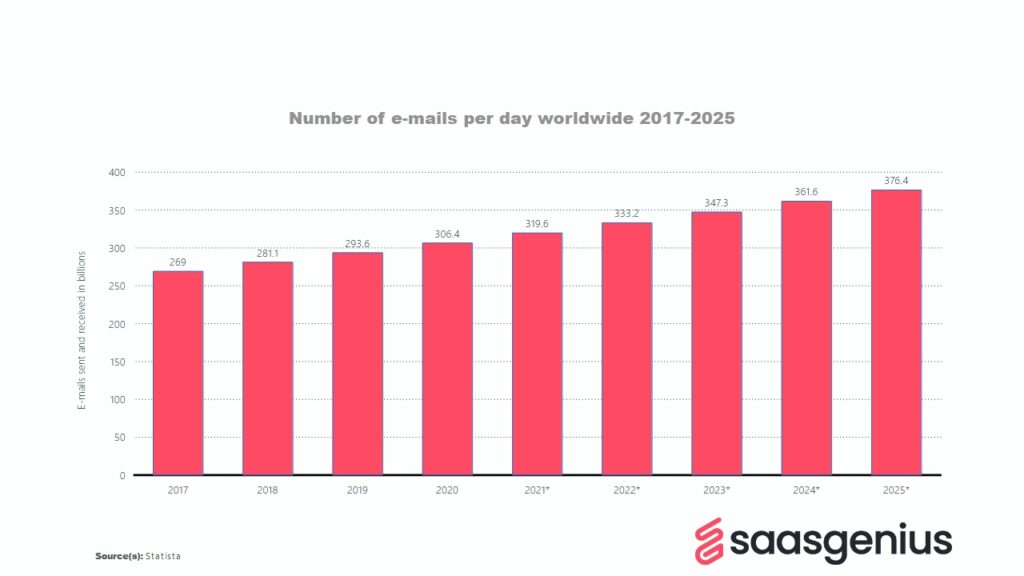How Many People Use Email for Communication
The way we communicate evolves all the time. Messaging apps gain and lose popularity, video calls have become commonplace, and thanks to chatbots, we even communicate with algorithms pretending to be human beings.
However, one thing doesn’t change. Regardless of chat and video-call apps, email communication is ever-present and won’t go away anytime soon.
The number of email users constantly grows on a global scale, and experts predict that the trend will continue in the next few years. According to Statista, in 2025, around 4.6 billion people will use email.

Email Usage Statistics
On average, email users receive between 100 and 120 emails per day, while a working professional sends about 40 emails daily. Expert projections say internet users will send out 376.4 billion emails in 2025.

What does that mean for your business? Every year, we have people claiming email will slowly die out, and reaching out via email will become relevant. Every year, they are proven wrong.
Email marketing is still one of the most prominent and efficient ways to generate and convert leads, increase engagement, and establish your brand. Global email marketing revenue in 2022 was $9.62 billion, and that number will reach $17.9 billion in 2027.
You can set up various email marketing campaigns to increase your sales significantly. However, running a successful campaign takes a lot of time and planning; doing it manually is a nightmare. Check out the best email marketing software that can help you automate the process and reach your goals quickly.
Interesting Email Usage Facts
Email marketing is not an easy marketing channel to master. Click-through rates of promotional and business emails are low, varying from 1.6% to 3.1% on average. Still, about 81% of businesses utilize email marketing to market their products and services to existing and potential customers.
According to Statista, the key objective of email marketing is to increase product awareness and offer promotions. The most popular objectives (with the percentage of marketers choosing them) are as follows:
- Product awareness and promotions: 63.49%
- Retention: 58.73%
- Acquisition: 57.14%
- Newsletters: 50%
- Transactional communication: 34,13%
- Surveys and data collection: 21.43%
Popular Email Campaign Types
Depending on the objective of email marketing and your business model, your approach to it needs to differ. A sent email can be the difference between a customer and a window shopper that doesn’t make a purchase.
Surveys show that the most popular campaign is a newsletter, followed by promotional and welcome emails. Check out the table below to see what campaigns marketers run most commonly:
| Email Marketing Campaign Type | Share of Marketers |
|---|---|
| Newsletter | 83.33% |
| Promotional | 72.73% |
| Welcome | 71.21% |
| Onboarding | 66.67% |
| Lead nurture | 60.61% |
| Surveys | 51.52% |
| Feedback | 48.48% |
| Invitations | 48.48% |
| Seasonal | 46.97% |
| Cart/browse abandonment | 37.88% |
| Cold email | 37.88% |
| Milestones | 19.7% |
| Others | 3% |
Summary
Despite the constant evolution of our means of communication, we love letters, both sending and receiving them. Emails have replaced physical letters and have made it possible to send hundreds of billions of them annually.
As a business owner, you can capitalize on the people’s habit of reading emails and increase your client base with a successful email marketing campaign. With over 4 billion people using email, if you reach only one permille of them, your business will become a huge success.
Related Articles
Author
Methodology
- Who?
We are SaaS experts: Our specialists constantly seek the most relevant information to help support your SaaS business. - Why?
We are passionate about users accessing fair SaaS pricing: We offer up-to-date pricing data, reviews, new tools, blogs and research to help you make informed SaaS pricing decisions. - How?
With accurate information: Our website manager tests each software to add a Genius Score using our rating methodology to each product. Our editorial team fact-check every piece of content we publish, and we use first-hand testing, value metrics and leading market data.
